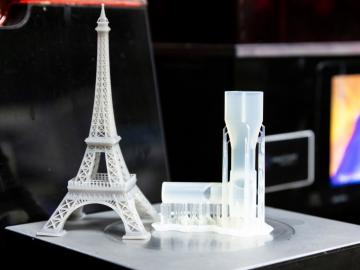
Filter News
Area of Research
- (-) Biology and Environment (177)
- (-) Isotopes (35)
- (-) National Security (79)
- (-) Supercomputing (311)
- Advanced Manufacturing (34)
- Biological Systems (18)
- Biology and Soft Matter (5)
- Building Technologies (12)
- Chemical and Engineering Materials (4)
- Chemistry and Physics at Interfaces (11)
- Clean Energy (522)
- Climate and Environmental Systems (14)
- Computational Biology (6)
- Computational Chemistry (5)
- Computational Engineering (5)
- Computer Science (19)
- Data (1)
- Earth Sciences (1)
- Electricity and Smart Grid (3)
- Energy Frontier Research Centers (14)
- Energy Sciences (5)
- Fossil Energy (3)
- Fuel Cycle Science and Technology (3)
- Functional Materials for Energy (16)
- Fusion and Fission (54)
- Fusion Energy (17)
- Geographic Information Science and Technology (3)
- Isotope Development and Production (3)
- Materials (433)
- Materials Characterization (2)
- Materials for Computing (36)
- Materials Synthesis from Atoms to Systems (13)
- Materials Under Extremes (12)
- Mathematics (1)
- Neutron Data Analysis and Visualization (4)
- Neutron Science (190)
- Nuclear Science and Technology (74)
- Nuclear Systems Modeling, Simulation and Validation (3)
- Nuclear Systems Technology (1)
- Quantum Condensed Matter (4)
- Quantum information Science (9)
- Reactor Technology (1)
- Renewable Energy (4)
- Sensors and Controls (5)
- Transportation Systems (11)
News Type
News Topics
- 3-D Printing/Advanced Manufacturing (15)
- Advanced Reactors (3)
- Artificial Intelligence (49)
- Big Data (28)
- Bioenergy (50)
- Biology (76)
- Biomedical (33)
- Biotechnology (14)
- Buildings (6)
- Chemical Sciences (14)
- Clean Water (11)
- Climate Change (53)
- Composites (5)
- Computer Science (112)
- Coronavirus (24)
- Critical Materials (4)
- Cybersecurity (23)
- Decarbonization (23)
- Energy Storage (13)
- Environment (103)
- Exascale Computing (24)
- Frontier (28)
- Fusion (3)
- Grid (13)
- High-Performance Computing (53)
- Hydropower (8)
- Irradiation (1)
- Isotopes (25)
- Machine Learning (26)
- Materials (28)
- Materials Science (24)
- Mathematics (3)
- Mercury (7)
- Microscopy (16)
- Molten Salt (1)
- Nanotechnology (16)
- National Security (36)
- Net Zero (3)
- Neutron Science (17)
- Nuclear Energy (12)
- Partnerships (8)
- Physics (9)
- Polymers (4)
- Quantum Computing (19)
- Quantum Science (25)
- Renewable Energy (1)
- Security (14)
- Simulation (23)
- Software (1)
- Space Exploration (6)
- Summit (46)
- Sustainable Energy (37)
- Transformational Challenge Reactor (1)
- Transportation (10)
Media Contacts

Outside the high-performance computing, or HPC, community, exascale may seem more like fodder for science fiction than a powerful tool for scientific research. Yet, when seen through the lens of real-world applications, exascale computing goes from ethereal concept to tangible reality with exceptional benefits.

A new nanoscience study led by a researcher at ORNL takes a big-picture look at how scientists study materials at the smallest scales.

Madhavi Martin brings a physicist’s tools and perspective to biological and environmental research at the Department of Energy’s Oak Ridge National Laboratory, supporting advances in bioenergy, soil carbon storage and environmental monitoring, and even helping solve a murder mystery.

Mike Huettel is a cyber technical professional. He also recently completed the 6-month Cyber Warfare Technician course for the United States Army, where he learned technical and tactical proficiency leadership in operations throughout the cyber domain.

Autonomous labs are changing the nature of scientific investigation. Instead of humans manually orchestrating every part of an experiment, programmed equipment can carry out necessary functions. This workflow accelerates the pace of discovery by reducing the number of monotonous tasks that researchers must perform.

Cody Lloyd became a nuclear engineer because of his interest in the Manhattan Project, the United States’ mission to advance nuclear science to end World War II. As a research associate in nuclear forensics at ORNL, Lloyd now teaches computers to interpret data from imagery of nuclear weapons tests from the 1950s and early 1960s, bringing his childhood fascination into his career

It was reading about current nuclear discoveries in textbooks that first made Ken Engle want to work at a national lab. It was seeing the real-world impact of the isotopes produced at ORNL

In the search for ways to fight methylmercury in global waterways, scientists at Oak Ridge National Laboratory discovered that some forms of phytoplankton are good at degrading the potent neurotoxin.

Mirko Musa spent his childhood zigzagging his bike along the Po River. The Po, Italy’s longest river, cuts through a lush valley of grain and vegetable fields, which look like a green and gold ocean spreading out from the river’s banks.

ORNL, the Department of Energy’s largest multidisciplinary laboratory, and Fairbanks Morse Defense, a portfolio company of Arcline Investment Management, have entered into a Memorandum of Understanding to collaborate on the development and integration of alternative fuel technologies aimed at reducing the marine engine’s reliance on fossil fuels.


